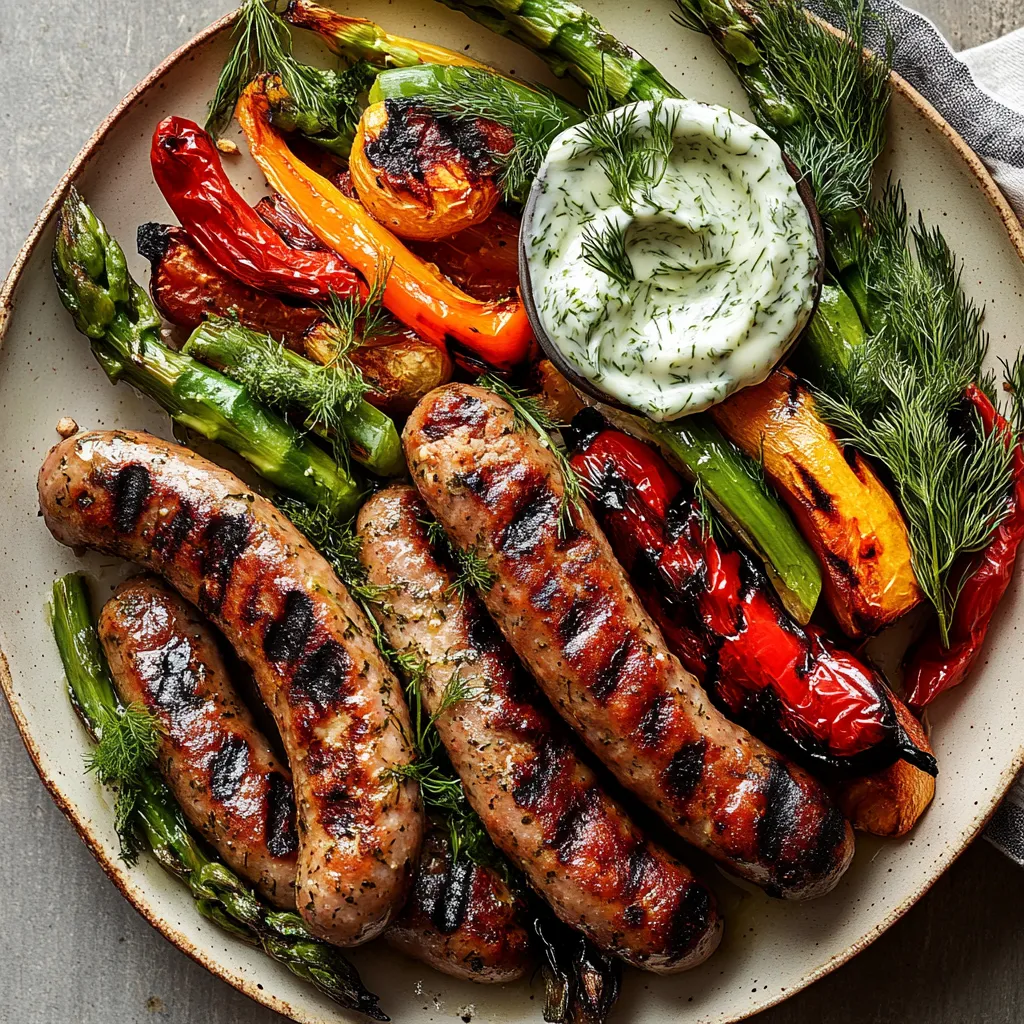 Pin it
Pin it
This grilled sausage and vegetables with creamy dill dip has become my summer go-to for effortless entertaining. The smoky char from the grill combines perfectly with the cool, herby dip that guests always rave about.
I first made this for an impromptu backyard gathering when friends stopped by unexpectedly. The platter was empty within minutes, and now it's requested at every summer barbecue we host.
Ingredients
- Italian sausage: Choose high-quality sausage with visible herbs and a good meat-to-fat ratio for the best flavor.
- Seasonal vegetables: Bell peppers, zucchini, red onion, and asparagus all grill beautifully and develop sweet caramelization.
- Extra virgin olive oil: Use a good quality oil as it forms the base of both the vegetable coating and the dip.
- Fresh dill: The bright, grassy notes cut through the richness of the grilled sausage perfectly.
- Mayonnaise: Creates the creamy base for our dip. Choose a high-quality version for best results.
- Fresh garlic: Provides essential pungency that balances the creaminess of the dip.
- Parmesan cheese: Adds umami depth and saltiness to the dip. Freshly grated makes a noticeable difference.
- Lemon juice: The acidity brightens all the flavors and cuts through the richness.
Step-by-Step Instructions
- Prepare the Grill:
- Preheat your grill to medium heat, around 350-375°F. This moderate temperature ensures the sausages cook through without burning and allows vegetables to char nicely while remaining tender. If using a grill pan, allow it to heat thoroughly before adding any food.
- Grill the Sausages:
- Place your Italian sausages directly on the grill grates. Cook them for 12-15 minutes, turning them every 3-4 minutes to ensure even browning on all sides. Look for an internal temperature of 160°F and a beautifully caramelized exterior. The slow cooking allows the fat to render properly, keeping the sausages juicy.
- Prepare and Grill Vegetables:
- While the sausages cook, toss your chosen vegetables in olive oil, sea salt, and freshly cracked black pepper, ensuring every piece is lightly coated. Transfer to a grill basket to prevent smaller pieces from falling through the grates. Grill for 6-8 minutes, turning occasionally, until vegetables develop grill marks and become tender but still retain some bite.
- Make the Creamy Dill Dip:
- Combine olive oil, mayonnaise, minced garlic, fresh dill, garlic powder, onion powder, lemon juice, grated Parmesan, salt, and pepper in a blender or food processor. Blend until completely smooth, stopping to scrape down the sides as needed. The dip should be thick enough to coat the back of a spoon but still pourable.
- Assemble and Serve:
- Slice the grilled sausages into diagonal pieces about ½-inch thick. Arrange them artfully on a large platter alongside the grilled vegetables. Drizzle some of the creamy dill dip over the top, with the remainder in a bowl for additional dipping. Garnish with extra fresh dill if desired for visual appeal.
 Pin it
Pin it
The fresh dill is truly the star ingredient here. I grow it in my garden specifically for this recipe. My husband once claimed he disliked dill until he tried this dip. Now he encourages our herb garden expansion just to ensure we always have enough for this dish.
Make-Ahead Options
The creamy dill dip can be prepared up to three days in advance and stored in an airtight container in the refrigerator. In fact, I find the flavors meld and improve after about 24 hours of chilling time. If making ahead, you might need to add a splash of water or olive oil to thin it slightly before serving as it tends to thicken when refrigerated. Just whisk it vigorously until the desired consistency returns.
Vegetable Variations
The beauty of this recipe lies in its adaptability to whatever vegetables are in season. In spring, try asparagus, spring onions, and halved radishes. Summer calls for zucchini, eggplant, and colorful bell peppers. Fall brings opportunities for Brussels sprouts, butternut squash slices, and mushrooms. Winter can still work with heartier options like thick-cut sweet potatoes, parsnips, and fennel. Just adjust cooking times accordingly based on density.
Serving Suggestions
This platter works beautifully as a complete meal, but also pairs wonderfully with simple sides. Try serving alongside a crisp green salad dressed with lemon vinaigrette, warm crusty bread for soaking up extra dip, or a simple grain salad like tabbouleh or quinoa with herbs. For entertaining, I often include a board of olives, cheeses, and nuts to complement the flavors and create a Mediterranean-inspired spread that guests can graze on.
 Pin it
Pin it
Enjoy this vibrant and versatile dish for your next gathering—it's a guaranteed crowd-pleaser!
Frequently Asked Questions
- → What vegetables work best with this grilled sausage dish?
Bell peppers, zucchini, red onion, and asparagus work particularly well, but you can customize based on seasonal availability. Choose vegetables that hold up well to grilling and won't fall through the grill grates. Eggplant, mushroom caps, and thick tomato slices are also excellent options.
- → Can I prepare the dill sauce ahead of time?
Yes! The creamy dill sauce can be prepared up to 3 days in advance and stored in an airtight container in the refrigerator. This actually allows the flavors to develop more fully. Just give it a quick stir before serving.
- → What can I substitute for Italian sausage?
You can substitute with any favorite sausage variety—chicken, turkey, or plant-based sausages all work well. Just adjust cooking times accordingly as leaner sausages typically cook faster than fattier options.
- → Is there a dairy-free alternative for the dill sauce?
For a dairy-free version, omit the Parmesan cheese and use a plant-based mayonnaise. You can add nutritional yeast (1-2 tablespoons) to achieve a similar cheesy flavor profile and a bit more lemon juice for extra tanginess.
- → How can I cook this without a grill?
You can easily adapt this for stovetop cooking using a grill pan or cast-iron skillet. You can also roast the vegetables in the oven at 425°F (220°C) for 20-25 minutes while pan-searing the sausages until they reach an internal temperature of 160°F (71°C).
- → What herbs can I use instead of dill?
Fresh basil, parsley, chives, or tarragon would all work wonderfully as alternatives to dill. Each will provide a different flavor profile—basil for Mediterranean notes, parsley for brightness, chives for mild onion flavor, or tarragon for a subtle licorice hint.
